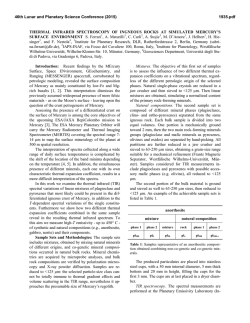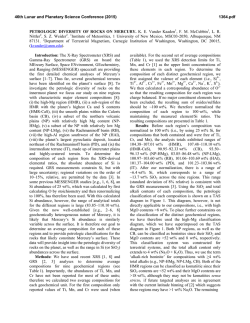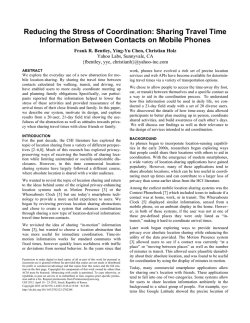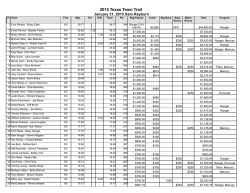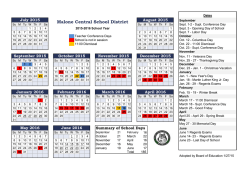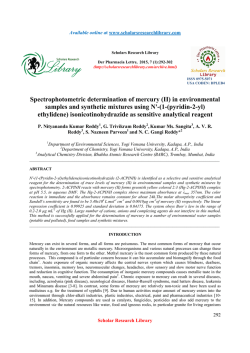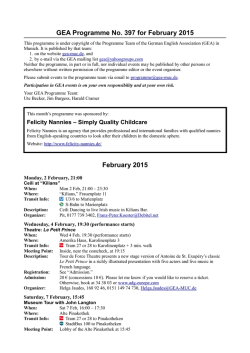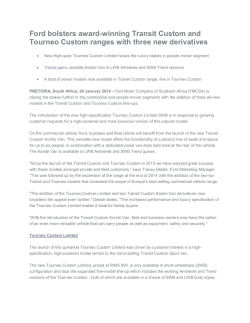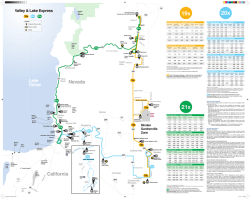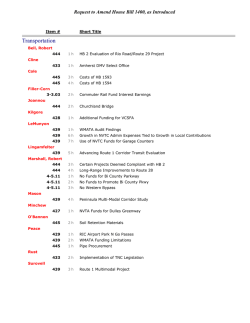
THE 9 MAY 2016 MERCURY TRANSIT – A TIMELY OPPORTUNITY
46th Lunar and Planetary Science Conference (2015) 1327.pdf THE 9 MAY 2016 MERCURY TRANSIT – A TIMELY OPPORTUNITY FOR OUTREACH. D. A. Rothery, Dept of Physical Sciences, The Open University, Milton Keynes, MK7 6AA, UK ([email protected]) Introduction: People across most of the globe will have a chance to witness Mercury’s next solar transit, 11:12-18:42 UT, Monday 9 May 2016 (Fig. 1). The transit should be webstreamed for the benefit of those in darkness or afflicted by cloud. Occurring a year after the end of the MESSENGER mission and a few months before the launch of BepiColombo, this transit (the first since 2006) will be an ideal occasion to draw the public’s attention to the science goals of those missions, to showcase what we have recently learned about Mercury, and to draw attention to the conundrums that make Mercury such a fascinating object to study. Mercury transits: Although Mercury passes between the Earth and the Sun at least three times a year, its orbital inclination is such that exact alignment is rare, and can happen only in May or November (Table 1), when the Earth is close to one of the two points in its orbit where its orbital plane is intersected by the plane of Mercury’s orbit. When the alignment is sufficiently exact, Mercury transits across the face of the Sun, though because its angular size is only about 12 seconds of arc (about 1/150th of the Sun’s diameter) a magnified image is required to reveal it. Date (mid-transit) Start (UT) End (UT) 2003 May 7 05:13 10:32 2006 Nov 8 19:12 00:10 2016 May 9 11:12 18:42 2019 Nov 11 12:35 18:04 2032 Nov 13 06:41 11:07 2039 Nov 7 07:17 10:15 2049 May 7 11:03 17:44 2052 Nov 9 23:53 05:06 Table 1. Transits of Mercury this century, until 2052. Solar transits of Mercury are more common than those of Venus, and the first observation was achieved in 1631 by the French Jesuit astronomer Pierre Gassendi, thanks to a successful prediction by Johannes Kepler. There is no observational record of a transit of Venus until 1639, even though those can be seen by the naked eye. Precise observation of planetary transits played a key role in determining the scale of the Solar System, and observing the 3 June 1769 transit of Venus from Tahiti was a primary scientific goal of Captain Cook’s first voyage of circumnavigation on HMS Endeavour. Less well known is that the expedition’s astronomer Charles Green, along with Cook himself who was also a capable observer, observed a transit of Mercury on 9 November of the same year, from the shores of Mercury Bay in New Zealand. Green later fell ill, and died soon after putting out from Batavia (modern-day Jakarta) in 1771, but is credited with being the first to note that Mercury’s crisp outline during transit demonstrates that the planet must have little or no atmosphere. The 2016 opportunity: The 2004 and 2012 transits of Venus was accompanied by major outreach events, and stimulated day-long media interest. The 2016 Mercury transit offers a similar opportunity, which the Mercury science community should seize upon. It is especially timely as an occasion to showcase the science achieved by MESSENGER and planned for BepiColombo. As a bonus, outreach infrastructure and momentum should still be fresh enough to re-use for the next transit, on 11 Nov 2019. Inexpensive solar projectors adequate to show the transit are readily available (Figs 2 and 3), and a recent upsurge of amateurs posting H-alpha and Ca-K solar images via social media (e.g., [1]) shows that the amateur astronomy community is well-equipped to observe the Sun. Subject to funding, plans in the UK include: awareness raising on social media via #MercuryTransit2016; a moderated webportal where astronomical societies, individuals, schools and universities will be encouraged to host transit viewing events, where anyone hosting an event can list their event and link to their own page, and where anyone seeking a nearby event will be able to find one; advice for safe viewing of the transit, and provision of cheap solar projectors to schools; a 'photowall' to which people can post their pictures of the transit (including ‘transit selfies’); online outreach materials about Mercury (e.g., [2]), BepiColombo, exoplanets (e.g., [3]) and the Sun; video interviews with Mercury scientists. Much of this material will appear incrementally during the months leading up to the 2016 transit, and remain in place for 2019 transit. Discussions have begun with the BBC about special TV programming and inserts to news broadcasts on the day. Whatever happens in the UK, ESA-TV may webstream live images of the transit from space (from Proba2 and possibly SOHO) so that people will be able to follow the transit even if their location is cloudy or the Sun is below their horizon. Similar initiatives may take place in other nations that have invested in BepiColombo, and it is hoped that there will be Europewide coordination and resource-sharing via the BepiColombo link on ESA’s website [4]. 46th Lunar and Planetary Science Conference (2015) 1327.pdf Figure 1: Visibility of Mercury’s solar transit, 9 May 2016. The shaded areas limit the hemispheres from which the Sun will be visible at first contact (11:12 UT) and last contact (18:42 UT). Cloud permitting, the whole transit will be visible from most of the Americas and western Europe. Only within a north-south belt from Manchuria to Australia will the whole duration be invisible. (map from http://www.venus-transit.de/Mercury2016/ ) Fig. 2. A commerically available solar projector that would show Mercury as a 0.5mm dot on a 7.5cm projected solar image. Available at less than £20 from http://www.astromediashop.co.uk/Astronomy.html. Fig. 3. A more robust solar projector, costing $399 from http://www.scientificsonline.com/product/sunspotter. References: [1] http://www.facebook.com/groups/solaractivity, [2] http://www.open.edu/openlearn/mercuryday, [3] http://www.open.edu/openlearn/science-mathstechnology/science/physics-andastronomy/astronomy/60-second-adventuresastronomy-exoplanets, [4] http://www.cosmos.esa.int
© Copyright 2025
